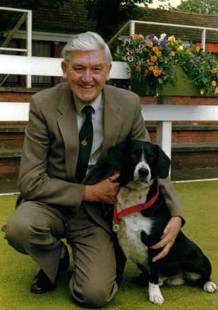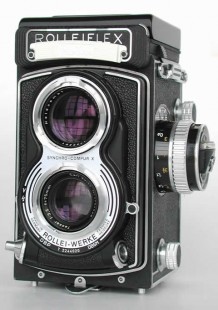Reading recent articles about Rollei and Franke & Heidecke, it seemed that other members might be interested in the story of my friend Roy Hargreaves, FRPS, FMPA, ABIPP, Hon FSWPP. Roy is now down the wrong end of his 80s, long retired from his business and living in a retired person’s bungalow in Freckleton. Like many servicemen, he obtained his first camera in Germany at the end of the war. In his case it was as a result of swapping cigarettes for a virtually useless radio which in turn was exchanged for a battered twin lens 1932 Rolleiflex. It came about, Roy says, like this:
When I had finished winning the war and putting an end to all the mayhem - a task which I accomplished with a modicum of help from my friends Eisenhower and Montgomery - I was posted to Northern Germany to await demobilisation. There I got the job of driving the “passion wagon” - the army truck which took soldiers into the town on short leave. This was because I was the only one likely to remain sober as I am “teetotal” - probably due to Grandfather Hargreaves being a hellfire and brimstone Methodist preacher around Burnley, Lancashire, with the consequence that I was brought up in a Methodist environment. The soldiers drank - I got hooked on photography. In those days there were many shortages in Germany. We could swap cigarettes and coffee for almost anything. I had a newish Blue Spot German radio which was so poor that you had to be virtually in sight of the station to catch a transmission (Nazi radios had circuits to prevent foreign transmissions being tuned which so constrained the receiver that it could hardly hear the home stations), but it was big, it had lots of lights on it and it was a precious item in post war Germany.
I exchanged it for my first Rollei - a 1932 Rolleiflex lever wind - in the displaced persons camp near Brunswick. After dropping my next load of soldiers from the “passion wagon” out for a day’s relaxation, I made my way to the Franke & Heidecke factory to see if my camera could be overhauled. On returning some days later to collect it I was told that it wasn’t quite ready and was ushered into a showroom with a display of monochrome prints by various internationally known photographers. I was then shown round the factory and I still have the booklet that was given to me as a souvenir on that auspicious occasion. I looked in this booklet and saw several of the pictures which I had seen in the display and from that moment on I was determined that I would become a professional photographer. As I was leaving I said to the gentleman who had showed me round “May I know your name?” and received the reply “I am Horste Franke”. I had been fortunate enough to be in the company of the son of the founder of the firm.
It is interesting to note that the Rollei booklet I was given indicated that the camera was designed as an amateur tool rather than as a professional camera, because in those days, professional cameras were mainly plate cameras. Of course the Rollei later became the preferred camera of many a professional.
After demob, I attended evening classes at Blackpool Technical College and joined the Blackpool Amateur Photographic Society but, having driven everything including a Sherman tank during my service days, it was natural for me to earn my living as a driver for Blackpool Council - albeit with a cab full of photographic books. In my spare time I took on photographic assignments - all the usual things like home portraits and weddings, using not the Rollei but a plate camera and tungsten lights and so learned to retouch negatives. All the processing was carried out in my home darkroom as there were no professional laboratories at the time.
In the fifties, having passed my City and Guilds final exam, I felt that I could really enter the world of professional photography and got a position at English Electric (later BAC, now BAE) where the darkroom work included the recording of tests on the Lightning fighter-bomber. The photographers were the black box of the day. A kind of photographic paper was used to record a trace of instrument readings in a process known as Trace Recording, and the output from several instruments was often recorded on one sheet so that the relative readings could be studied by the technical experts. “Sheet” is a misleading term: the paper was often 50 or 60 feet long and we, the developers sweated over enormous baths to develop the image. Through these tests it was found the Lightning was faster than the rockets it was firing, causing a test pilot to exclaim “the bloody things were coming back at me!”
From English Electric I moved to the photographic department of James Woolley Sons and Co. in Manchester where I became their Photographic Sales Consultant. Quoting from the firm’s leaflet, “Mr. Hargreaves is at your service: there is little he doesn’t know” (Wow!) I got out just in time as British Drug Houses took over the firm and nearly everyone lost their jobs. After a stiff interview I got a post with a shopfitting firm, largely because I had and could use stereo cameras and subsequently travelled the country recording the firm’s shopfittings, mostly with a De Vere plate camera. It was my first real job as a working photographer and my work was used to produce display books for 120 representatives.
In 1962 I married Greta, secretary to the aforementioned test pilots. Greta was not happy with my extended travels around Britain, so I took the plunge and opened up my own studio in Blackpool later the same year. Not being able, at the time, to afford ground floor premises, I settled for a first floor studio in an up market district of the town where I stayed until my retirement thirty years later. My business was a mix of portraits and weddings taken, at first, on an MPP, Linhoff and, of course Rollei, which I promoted with showcases on the stairs and in the hallway. I also became a part time tutor at Blackpool Technical College where I had started my own training all those years before. Over a period of time I gained in experience and confidence and became a seasoned photographer, adding to my portfolio portraits of many of the well known artists who came to Blackpool for the summer season and for Christmas pantomime.
In the ‘60s and ‘70s Blackpool was the place to be and everyone who was anybody came to star Carson, Jayne Mansfield and, in connection with the Miss UK contest, Michael Aspel. 1982 was a year of great success for me in the North West Annual Competition judged by Paul Kay FBIPP, coming first, third, fourth and fifth in the portrait section, all with my “girlie” pictures (my main influence had been the work of David Hamilton) and I also gained the BIPP National Portrait Photographer’s Award for that year. Pictures from this period were also included in the subjects of the lectures which I frequently gave and which I have only very recently, and with great reluctance, given up on health grounds.
Following on from these awards I achieved Fellowship of the Royal Photographic Society, Fellowship of the Master Photographers Association, Associateship of the British Institute of Professional Photographers and was later awarded an Honorary Fellowship of the Society of Wedding and Portrait Photographers. Sadly, it was my misfortune to lose Greta through a heart attack at a comparatively early age and for a while I was very depressed and felt rather low. When I managed to get over this, and for company, I got a little dog called Sam which went everywhere with me, including Institute meetings. In fact, Sam attended so many meetings and became so well known that he was made Honorary Associate of IBPP. This was pictured at the time, and Sam’s obituary appeared in the Institute’s magazine when he eventually died. I finally retired from full time photography in 1991 have done in excess of 2,000 weddings, countless portraits and much commercial photography but I continued lecturing into my eighties. Even now I still retain vivid memories of my visit to the Rollei factory and the inspiration which it provided for my life’s work. During that work I used almost every mechanical Rollei including tele and wideangle TLRs, 6 x 6 and 35 mm projectors for my talks and, later, SL66 and SLX.

